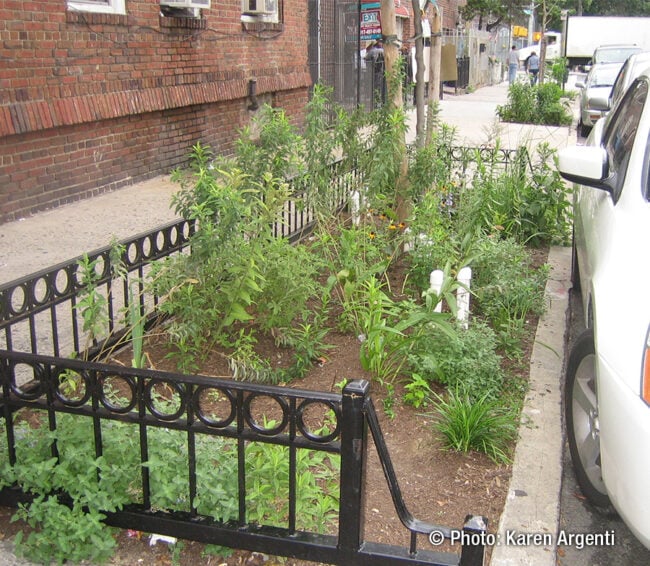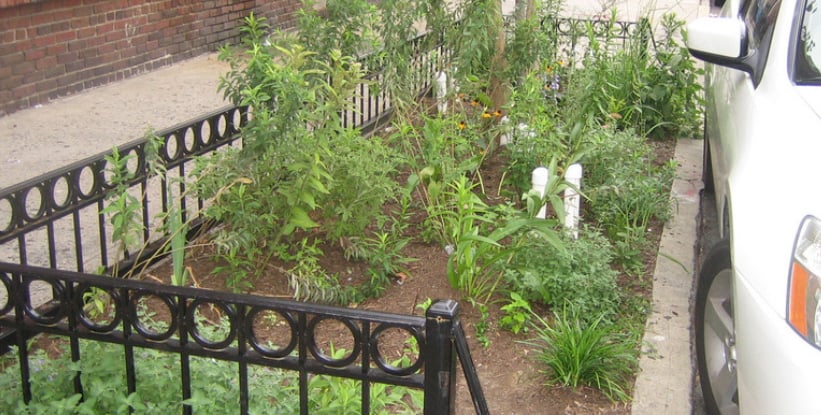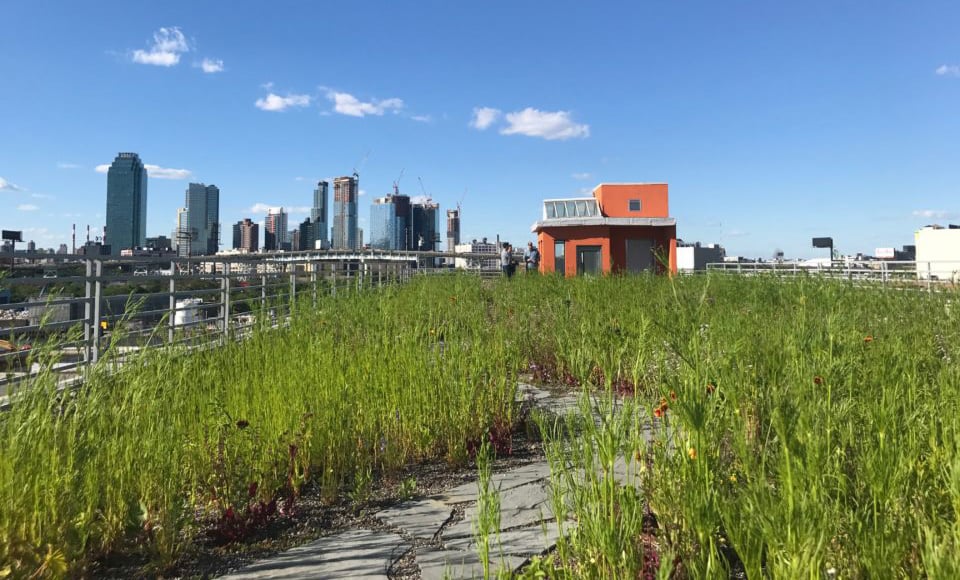State proposes changes to New York City’s Green Infrastructure Program

View more images on our Flickr site
Full green infrastructure development will be delayed by at least a decade, but implementation of Riverkeeper recommendations will strengthen program moving forward
On Friday May 19, 2023, the New York City Department of Environmental Protection held a press conference to announce modifications to its Green Infrastructure Program, the product of a 2012 Consent Order agreed to between New York City and New York State to reduce citywide combined sewer overflows (known as “CSOs”) by 1.67 billion gallons annually by 2030. The 2023 Citywide Green Infrastructure Modification requires NYCDEP to expend an additional $2 billion on green infrastructure to reduce CSOs by 1.67 billion gallons per year by 2040 on a citywide basis, with the potential to request an additional five years to achieve the CSO reduction goal by 2045. While the modification will delay pollution reduction benefits by 10 years, the state and city have proposed implementation of many of the practical recommendations Riverkeeper and coalition partners laid out in our 2022 Building an Equitably Green New York City report.

Though the proposed modifications reflect the reality that the city was never on track to achieve its green infrastructure goals by 2030, it’s worth acknowledging that the city has made tremendous progress toward implementing the largest green infrastructure program in the country. Because the city’s own red tape has stymied its contracts with landscape engineers, and the complexity of construction in the city’s public spaces has slowed projects, the city and state have preliminarily agreed to extend the deadline for full implementation by a decade. The delay, if finalized, would allow for greater raw sewage and polluted stormwater pollution during the next 17 to 22 years, not to mention it will hamper the city’s ability to meet its new commitment set forth the City’s long-term strategic climate plan, PlaNYC: Getting Sustainability Done, “to [end] the discharge of untreated sewer overflows by 2060.”
That said, despite the delay, the state and city have proposed important new commitments that are crucial for CSO reduction. First, the city will formally commit to an additional $2 billion in planned water quality and resiliency projects. This commitment should be sufficient to meet the 1.67 billion gallon CSO reduction target and also provide additional capacity for projects, such as Bluebelts, which are natural drainage systems like those that surround Staten Island, and neighborhood-wide “cloudburst” plans that reduce local precipitation-related flooding while improving water quality around the city. Riverkeeper called for these types of projects in our green infrastructure report and strongly supports these new, more adaptive ways that the city is managing stormwater as climate change threatens to cause more frequent and more intense storms.
Moreover, while the current Green Infrastructure Program provides funds for green infrastructure development in only areas served by combined sewers (roughly 60% of the city), the proposed changes would also allow for the development of green infrastructure projects in the separately sewered areas (known as “MS4 areas”) (the other 40%). This will allow for equity in the construction of green infrastructure throughout all New York City neighborhoods. We, along with coalition partners, have long requested the program’s expansion to these communities, such as Coney Island and parts of the Southeastern Bronx.
The city has also formally committed to completing the Tibbetts Brook Daylighting project in the Bronx, the single most effective green infrastructure project for improving water quality, capturing stormwater and enhancing quality of life in New York City. Not only will reconstructing the former brook – which will move the flow of stormwater from underground pipes back to a restored surface stream – prevent hundreds of millions of gallons of CSOs from entering the Harlem River, it will also create a greenway in one of the most heavily traffic-congested and polluted areas of the city. By channeling waters away from overwhelmed infrastructure, it will also reduce local flooding. The daylighting of Tibbetts Brook is a very big win for our coalition group partners and DEP, and would not have been possible without persistent community advocacy from partner organizations, particularly Bronx Council for Environmental Quality, as well as collaborative DEP staff. There remain other opportunities for waters in New York City that should also be daylighted to improve water quality and reduce local flooding, such as Kissena Creek, Flushing Creek, and Alley Creek watersheds in Queens, and we urge DEP to pursue them.
While we appreciate these important improvements to the program, Riverkeeper will continue to advocate for innovation. One top concern is discord caused by conflicting city agency goals. To alleviate inefficiencies, green infrastructure development must be integrated throughout all construction projects and incorporated into the missions of all relevant agencies, especially the Department of Transportation, Parks, and Design and Construction, as well as the New York City Housing Authority. The city needs better standards and mechanisms to incentivize green infrastructure development through all of these entities. These agencies must be both supported and made accountable for incorporating the development of new green infrastructure assets into their capital projects and provided the budget to do so, including funds for operation and maintenance.
 The city also needs clearer guidance on maintenance of constructed green infrastructure, such as rain gardens, green roofs, infiltration planters, trees, and rainwater harvesting systems. A 2019 City Comptroller report documented that poor maintenance is undermining the Green Infrastructure Program. Green infrastructure installations were left to wither—plants died, the areas became full of trash, and the sidewalk rails were broken. Unless the vegetation is healthy, it is ineffective at protecting water quality, and the day-to-day benefits for local neighborhoods cannot be felt. The proposed changes to the Green Infrastructure Program have no meaningful commitments for green infrastructure maintenance. Riverkeeper urges the city to agree to set funds aside in the capital infrastructure budget to guarantee sufficient, ongoing resources for maintenance.
The city also needs clearer guidance on maintenance of constructed green infrastructure, such as rain gardens, green roofs, infiltration planters, trees, and rainwater harvesting systems. A 2019 City Comptroller report documented that poor maintenance is undermining the Green Infrastructure Program. Green infrastructure installations were left to wither—plants died, the areas became full of trash, and the sidewalk rails were broken. Unless the vegetation is healthy, it is ineffective at protecting water quality, and the day-to-day benefits for local neighborhoods cannot be felt. The proposed changes to the Green Infrastructure Program have no meaningful commitments for green infrastructure maintenance. Riverkeeper urges the city to agree to set funds aside in the capital infrastructure budget to guarantee sufficient, ongoing resources for maintenance.
Next Steps
Looking forward, Riverkeeper will submit detailed comments on the proposed Consent Order modifications in support of the improvements to the city’s Green Infrastructure Program and also raising questions about the delays. And we will continue to work with DEP staff and others to optimize the program for the benefits of community health and water quality.
Background
Each year, New York City discharges more than 20 billion gallons of raw sewage into local waterways. That’s enough to fill the Empire State Building 72 times! These “combined sewer overflow” discharges occur because roughly 60% of the city is served by a combined sewer system in which stormwater runoff from rainstorms that collect pollutants from industrial sites, sidewalks, and streets mixes with sewage from homes and businesses and causes the system to overflow, dumping untreated sewage into waterways surrounding the city.
Riverkeeper has been fighting for years for major upgrades to sewage infrastructure, including green infrastructure. The term “green infrastructure” can have many meanings, but it typically refers to the retrofitting of roofs, sidewalks, streets and other impervious surfaces with soil and vegetation that soak up and slow stormwater runoff, preventing it from running directly to the sewer system.
What can you do?
New York State is accepting public comments on the New York City Green Infrastructure Consent Order modifications until June 16, 2023. If you’d like to know more about the modifications to the Green Infrastructure Consent Order, the city is hosting a discussion on June 1 at 5:30. Click here to register and ask any questions you have about the changes.
